 Remember
1997 and early 1998, the era of the real-time strategy game? It seemed
like not a week passed without the release of a new title seeking to
follow up on the success of Warcraft II and the original Command &
Conquer. Some of them were good; a lot of them were very bad. But when the
dust finally settled, there were three clear winners—Age of Empires,
Starcraft, and Command and Conquer: Red Alert. Since then, the Starcraft
empire has expanded by adding Brood War, as good an add-on pack as one
could ask for. On the other hand, fans of AoE and Red Alert have been
waiting (mostly impatiently) for follow-ups. Thus it was with much
anticipation that I opened up my Platinum edition of C&C: Tiberian
Sun. I’ve been playing it for a while now, and you know what? It’s
like 1997 all over again, only slicker, prettier, and better-balanced.
Remember
1997 and early 1998, the era of the real-time strategy game? It seemed
like not a week passed without the release of a new title seeking to
follow up on the success of Warcraft II and the original Command &
Conquer. Some of them were good; a lot of them were very bad. But when the
dust finally settled, there were three clear winners—Age of Empires,
Starcraft, and Command and Conquer: Red Alert. Since then, the Starcraft
empire has expanded by adding Brood War, as good an add-on pack as one
could ask for. On the other hand, fans of AoE and Red Alert have been
waiting (mostly impatiently) for follow-ups. Thus it was with much
anticipation that I opened up my Platinum edition of C&C: Tiberian
Sun. I’ve been playing it for a while now, and you know what? It’s
like 1997 all over again, only slicker, prettier, and better-balanced.
Whether you think that’s a good thing or a bad thing will probably
determine how you feel about Tiberian Sun, the game that dares to boldly
go where pretty much everyone has been before.
 Tiberian Sun
leaves behind the Soviet/NATO alternate history of Red Alert and returns
to the original C&C stare-down between the forces of the evil NOD and
virtuous GDI. It seems that NOD’s fearless leader, Kain, has
miraculously escaped the perdition that awaited him at the end of Command
and Conquer and has returned to bedevil GDI yet again. This time, he plans
to use the mutating properties of tiberium--the strange uber-resource of
the C&C world—to make the world over in his image. The story is
conveyed in a series of pricey and elaborate FMVs that star such actors as
James Earl Jones and Michael Biehn, and as such stories go, it’s a
pretty good one.
Tiberian Sun
leaves behind the Soviet/NATO alternate history of Red Alert and returns
to the original C&C stare-down between the forces of the evil NOD and
virtuous GDI. It seems that NOD’s fearless leader, Kain, has
miraculously escaped the perdition that awaited him at the end of Command
and Conquer and has returned to bedevil GDI yet again. This time, he plans
to use the mutating properties of tiberium--the strange uber-resource of
the C&C world—to make the world over in his image. The story is
conveyed in a series of pricey and elaborate FMVs that star such actors as
James Earl Jones and Michael Biehn, and as such stories go, it’s a
pretty good one.
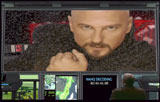 The campaigns
aren’t too shabby, either. You get to play as GDI or NOD, and the
Freeman, tiberium-warped mutants, also play a big part. Though there’s
no tutorial, the missions do a good job of gradually introducing you to
your units and their capabilities. The AI in the campaign games is fairly
sharp, and the scenarios themselves are challenging and interesting. Most
of them take curious little twists, and you’ll often have to attain
several objectives before completing the mission. However, if you’re
like me, you might gnash your teeth over the considerable number of
"commando" type missions. Some of these quite tense and
interesting, and require thoughtful base infiltration and prisoner rescue.
Some, on the other hand, are tedious exercises in load-and-save that are
more about painstakingly revealing map areas than strategy. Give me a
base-building shoot ‘em up anytime.
The campaigns
aren’t too shabby, either. You get to play as GDI or NOD, and the
Freeman, tiberium-warped mutants, also play a big part. Though there’s
no tutorial, the missions do a good job of gradually introducing you to
your units and their capabilities. The AI in the campaign games is fairly
sharp, and the scenarios themselves are challenging and interesting. Most
of them take curious little twists, and you’ll often have to attain
several objectives before completing the mission. However, if you’re
like me, you might gnash your teeth over the considerable number of
"commando" type missions. Some of these quite tense and
interesting, and require thoughtful base infiltration and prisoner rescue.
Some, on the other hand, are tedious exercises in load-and-save that are
more about painstakingly revealing map areas than strategy. Give me a
base-building shoot ‘em up anytime.
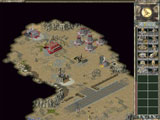 The game’s
graphics have been given a considerable overhaul since Red Alert. The
terrain is the best-looking thing about the game, and the dynamic lighting
is especially impressive. Adding to the landscape’s graphic allure is
its deformability—if a big wing of Orca bombers hits the enemy base,
they’ll leave a big smoking crater. Even better, these alterations to
the landscape will affect your tactics; for instance, a group of disc
throwers in a crater (the grenadiers of the TS world) will be able to
sling ordnance at direct-fire troops who can’t target them. Attack and
damage effects are pretty nifty, too. NOD Flame tanks spew sheets of fiery
death, igniting infantry that runs around in flames. GDI Titans use red
targeting lasers on their enemies, and the rays from disruptor tanks cut
swathes through enemy troops as damaged units spark and smoke.
Graphically, the units themselves are a bit of a mixed bag. The voxel-based
sprites sometimes look very nice—especially GDI Titans and Wolverines,
as well as NOD arty and the air units. But the NOD tanks are
disappointingly benign-looking. Infantry isn’t especially striking, but
if you’re playing at 800x600 they’re so small that detail isn’t
really an issue. Overall, however, as with so many other aspects of the
game, there’s nothing really inspired about the graphics. The
overall impression is one of extreme competence.
The game’s
graphics have been given a considerable overhaul since Red Alert. The
terrain is the best-looking thing about the game, and the dynamic lighting
is especially impressive. Adding to the landscape’s graphic allure is
its deformability—if a big wing of Orca bombers hits the enemy base,
they’ll leave a big smoking crater. Even better, these alterations to
the landscape will affect your tactics; for instance, a group of disc
throwers in a crater (the grenadiers of the TS world) will be able to
sling ordnance at direct-fire troops who can’t target them. Attack and
damage effects are pretty nifty, too. NOD Flame tanks spew sheets of fiery
death, igniting infantry that runs around in flames. GDI Titans use red
targeting lasers on their enemies, and the rays from disruptor tanks cut
swathes through enemy troops as damaged units spark and smoke.
Graphically, the units themselves are a bit of a mixed bag. The voxel-based
sprites sometimes look very nice—especially GDI Titans and Wolverines,
as well as NOD arty and the air units. But the NOD tanks are
disappointingly benign-looking. Infantry isn’t especially striking, but
if you’re playing at 800x600 they’re so small that detail isn’t
really an issue. Overall, however, as with so many other aspects of the
game, there’s nothing really inspired about the graphics. The
overall impression is one of extreme competence.
The game’s interface is pretty much the same as that in Red Alert.
Westwood has had the good sense to crib relentlessly from the advances in
RTS games over the last couple of years—for example, you can queue units
in production and use waypoints and scads of hot keys. But the game’s
screen looks almost exactly like Red Alert’s, with scrolling production
options and the strategic map taking up the right side of the screen. If
you’ve played RA, you’ll be at home immediately.
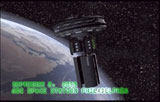 While gameplay
will seem in many ways very familiar, it’s also the area in which
Tiberian Sun differs most from Red Alert. Some of the basics remain the
same: taking out enemy harvesters is still a very effective strategy, and
it’s still very hard to protect them. I’ve always found this one of
the most irritating things about the C&C series. Since you can only
build in the immediate vicinity of existing buildings, the only way to
fortify the distant tiberium fields you’ll find yourself farming is by
building an expensive and vulnerable MCV and sending it off, or by
leapfrogging power stations. Too bad TS didn’t take its lead from
Starcraft here, which allows its SCVs to build anywhere. Westwood has
included a "harvester truce" option that allows you to make
harvesters invulnerable, but it seems an awkward compromise that makes
resource gathering either of the utmost importance or of none at all.
While gameplay
will seem in many ways very familiar, it’s also the area in which
Tiberian Sun differs most from Red Alert. Some of the basics remain the
same: taking out enemy harvesters is still a very effective strategy, and
it’s still very hard to protect them. I’ve always found this one of
the most irritating things about the C&C series. Since you can only
build in the immediate vicinity of existing buildings, the only way to
fortify the distant tiberium fields you’ll find yourself farming is by
building an expensive and vulnerable MCV and sending it off, or by
leapfrogging power stations. Too bad TS didn’t take its lead from
Starcraft here, which allows its SCVs to build anywhere. Westwood has
included a "harvester truce" option that allows you to make
harvesters invulnerable, but it seems an awkward compromise that makes
resource gathering either of the utmost importance or of none at all.
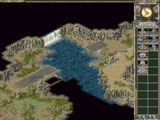 On the other
hand, Westwood has done a remarkable job of balancing play. NOD has all
manner of nifty sneaky stuff, including burrowing tanks, deadly (maybe too
deadly) artillery, and cloaking devices. GDI has more conventional—but
more powerful--units. And the Freemen have some nasty units as well,
including the railgun-equipped ghoststalker and the pernicious mutant
hijacker. Overall, the variety and balance of units is terrific. From the
Cyborg Commandos to Jump Troopers to Amphibious APC’s, each unit offers
intriguing tactical possibilities. Though lamentably lacking air-to-air
combat (what’s up with that?), combat in Tiberian Sun is as challenging
and thoughtful as in any RTS game. This is a big improvement on Red Alert,
the game that spawned the term "tank rush." You won’t get away
with that in TS. Though many have tried to come up with so-called
"unbeatable" rush strategies for TS on Westwood Online, thus far
someone’s found a counter for each of them.
On the other
hand, Westwood has done a remarkable job of balancing play. NOD has all
manner of nifty sneaky stuff, including burrowing tanks, deadly (maybe too
deadly) artillery, and cloaking devices. GDI has more conventional—but
more powerful--units. And the Freemen have some nasty units as well,
including the railgun-equipped ghoststalker and the pernicious mutant
hijacker. Overall, the variety and balance of units is terrific. From the
Cyborg Commandos to Jump Troopers to Amphibious APC’s, each unit offers
intriguing tactical possibilities. Though lamentably lacking air-to-air
combat (what’s up with that?), combat in Tiberian Sun is as challenging
and thoughtful as in any RTS game. This is a big improvement on Red Alert,
the game that spawned the term "tank rush." You won’t get away
with that in TS. Though many have tried to come up with so-called
"unbeatable" rush strategies for TS on Westwood Online, thus far
someone’s found a counter for each of them.
Multiplayer is supported over LAN, modem and on Westwood Online, and is
one of the game’s real strengths. I predict that the variety of units
and abilities will have players coming up unique strategies for a long
time.
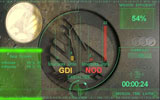 There are still
some niggling problems: while pathfinding is usually excellent, harvesters
are still prone to do unbelievably stupid things, and riding herd on them
is perhaps the most aggravating thing about the game. And for some reason,
you can’t ally with other players during skirmish or modem games.
Finally, while Westwood online is usually very stable, it’s not quite as
fast or reliable as Battle.net.
There are still
some niggling problems: while pathfinding is usually excellent, harvesters
are still prone to do unbelievably stupid things, and riding herd on them
is perhaps the most aggravating thing about the game. And for some reason,
you can’t ally with other players during skirmish or modem games.
Finally, while Westwood online is usually very stable, it’s not quite as
fast or reliable as Battle.net.
Here’s the bottom line: Westwood took precisely no risks with
Tiberian Sun, and turned out a game that plays and looks a lot like Red
Alert, only with nicer graphics, better balance, and state-of-the-art RTS
amenities. It seems that Westwood will be waiting until Command and
Conquer: Renegade to produce a truly revolutionary game. In the meantime,
Tiberian Sun is merely an extremely well-done edition of a tried-and-true
game engine. If you’re happy with that, you’ll love Tiberian Sun; if
you expected something more after such a long wait, you’ll be
disappointed.
--Rick
Fehrenbacher

 Remember
1997 and early 1998, the era of the real-time strategy game? It seemed
like not a week passed without the release of a new title seeking to
follow up on the success of Warcraft II and the original Command &
Conquer. Some of them were good; a lot of them were very bad. But when the
dust finally settled, there were three clear winners—Age of Empires,
Starcraft, and Command and Conquer: Red Alert. Since then, the Starcraft
empire has expanded by adding Brood War, as good an add-on pack as one
could ask for. On the other hand, fans of AoE and Red Alert have been
waiting (mostly impatiently) for follow-ups. Thus it was with much
anticipation that I opened up my Platinum edition of C&C: Tiberian
Sun. I’ve been playing it for a while now, and you know what? It’s
like 1997 all over again, only slicker, prettier, and better-balanced.
Remember
1997 and early 1998, the era of the real-time strategy game? It seemed
like not a week passed without the release of a new title seeking to
follow up on the success of Warcraft II and the original Command &
Conquer. Some of them were good; a lot of them were very bad. But when the
dust finally settled, there were three clear winners—Age of Empires,
Starcraft, and Command and Conquer: Red Alert. Since then, the Starcraft
empire has expanded by adding Brood War, as good an add-on pack as one
could ask for. On the other hand, fans of AoE and Red Alert have been
waiting (mostly impatiently) for follow-ups. Thus it was with much
anticipation that I opened up my Platinum edition of C&C: Tiberian
Sun. I’ve been playing it for a while now, and you know what? It’s
like 1997 all over again, only slicker, prettier, and better-balanced.